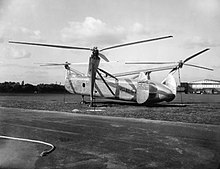Cierva Autogiro
| Cierva Autogiro | |
|---|---|
| legal form | Ltd. |
| founding | 1926 |
| resolution | 1975 |
| Seat | Southampton |
| management | James George Weir |
| Branch | Aviation industry |
The Cierva Autogiro Company , based in Southampton , was founded in 1926 by James George Weir (1887–1973) and the Spanish aviation pioneer Juan de la Cierva (1895–1936). The company became known for the development of series-ready gyroplanes , which were also built under license in large numbers. In the 1940s, Cierva had what was then the largest helicopter in the world built.
Autogiro was Cierva's registered trademark for gyrocopter, which is also known as Autogyro in Germany.
history
The first gyroplanes were built in close cooperation with the company AV Roe and were thus also given their type designations (e.g. Cierva C.6D / Avro 587). The C.6D , built in England, is considered to be the world's first two-seat gyroplane. In 1926 the first C.6s were delivered to the Royal Air Force in England. Other nations also showed interest in this device at the time. On September 5, 1926, Ernst Udet flew the C.6D at Berlin-Tempelhof airfield.
On September 18, 1928, Juan de la Cierva was able to fly over the English Channel between Lympne and Calais (around 40 kilometers) in his Autogiro Cierva C.8L Mk.II at an altitude of 1200 meters and with a total flight time of 18 minutes .
In 1928, Cierva laid the foundation for series production in the USA with the founding of the Autogiro Co. of América . The licensee was the multi-millionaire flying enthusiast Harold Frederick Pitcairn (1897–1960), who also gave the production its name under the abbreviation PCA . The 300 hp machines of the PCA-2 series completed flights to Mexico and Cuba.
In 1932, Cierva Autogiro GmbH was founded in Berlin . In the following years until 1938, the Focke-Wulf company built a total of 43 C.30 gyroplanes under their license. This machine became known as the Fw 30 grasshopper . In 1933 the type C.30 began to be delivered to end customers in France, Sweden, Holland, Austria, Australia, Switzerland, Japan and Germany. As a result, Cierva sold the C.21 a license to Lioré & Olivier in France. However, only the LeO C.301, which was a license for the C.30, was produced in series.
After de la Cierva's death in 1936 when a scheduled flight crashed, his partner continued to run the business. After the development of gyroscopes, aircraft engines were now developed and manufactured. Because of the Second World War , Cierva was founded in 1944 with the helicopter manufacturer G. & J.Weir Ltd. merged in Glasgow . The guys now also had the W for Weir.
The Cierva W.14 helicopter was built in the late 1940s. It was a small two-seat helicopter that was one of the first to be successful in Great Britain. The Skeeter was only ready for series production through further development at Saunders-Roe , which acquired the rights in 1951. The Bundeswehr had procured eleven Skeeter Mk.50 and 51, but they were never used by the Air Force or Navy.
With the Cierva W.11 Air Horse , a transport helicopter was developed. When the machine made its first untethered flight on December 8, 1948, it also set a world record for rotary wing aircraft with a takeoff weight of 6600 kg (14,600 lb) . It was the largest helicopter in the world at the time and was unique in that it had three main rotors , a design that was never used again before or after.
One of the two prototypes crashed on June 13, 1950 during test flights due to material fatigue. The death of the three pilots meant the temporary end of Cierva. Since the British government lost interest in procurement after this accident, the project was discontinued and Saunders-Roe took over the factory facilities of the manufacturer who had built the two W.11s at Eastleigh Airport on behalf of Cierva. The Weir Group , today one of the largest pump manufacturers in the world, withdrew from the rotorcraft sector. James George Weir was subsequently only involved with his private funds.
In 1969, Cierva took over the Rotorcraft company and brought the joint development, the CR Twin Grasshopper III, to flight maturity. The maiden flight of the first of three prototypes took place on August 18, 1969. The light helicopter (formerly CR LTH.1 ) was designed for one pilot and four passengers.
Trivia
In the film The 39 Steps by Alfred Hitchcock , James George Weir flies a gyroplane made by this manufacturer.
Types of the Cierva Autogiro Company (selection)
Gyroplane
- Cierva C.6 (Avro 574, 575)
- Cierva C.8
- Cierva C.9 (Avro 576)
- Cierva C. 19 (Avro 620)
- Cierva C.30 (Avro 671)
- Cierva C.33 (Avro 665) Project of a four-seat cabin gyroplane
- Cierva C.37 (Avro 668) Project of a twin-engine gyroplane
- Cierva C.40
License building abroad
- Focke-Wulf C. 20 Don Quixote
- Focke-Wulf Fw 30 grasshopper (C.30)
- Lioré & Olivier C. 21
- Lioré & Olivier LeO C.301 (C.30)
helicopter
- Cierva W.9
- Cierva W. 14 Skeeter
- Cierva W.11 Air Horse
- Cierva CR Twin Grasshopper III
literature
- AJ Jackson: Avro Aircraft since 1908. London 1965. pp. 433ff
- Michael JH Taylor: Jane's Encyclopedia of Aviation. London 1989. pp. 254f ISBN 978-0-517-10316-6
- William Weir: History of the Weir Group. Profile 2008. ISBN 978-1-86197-886-8
- Bruce H. Charnov: From Autogiro to Gyroplane , Praeger, Westport Connecticut 2003, ISBN 1-56720-503-8
Web links
- Flight: CIERVA AUTOGIRO Co., Ltd. Edition of December 9, 1926, p. 810 (pdf 259 kB)
- Flight: Air Horse Tragedy issue of June 22, 1950, p. 747 (pdf 393 kB)





